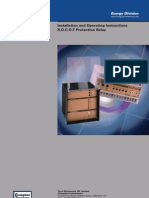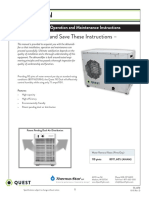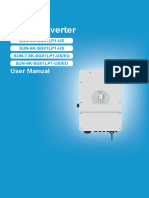01.4TB.084 Capacitor Trip Unit
01.4TB.084 Capacitor Trip Unit
Uploaded by
Mahyar MashayekhiCopyright:
Available Formats
01.4TB.084 Capacitor Trip Unit
01.4TB.084 Capacitor Trip Unit
Uploaded by
Mahyar MashayekhiOriginal Description:
Copyright
Available Formats
Share this document
Did you find this document useful?
Is this content inappropriate?
Copyright:
Available Formats
01.4TB.084 Capacitor Trip Unit
01.4TB.084 Capacitor Trip Unit
Uploaded by
Mahyar MashayekhiCopyright:
Available Formats
Capacitor Trip Unit
November 17, 1998
A capacitor trip unit is a prepackaged module that supplies power for tripping an AC controlled circuit
breaker with discrete relays following the loss of the AC control voltage. DC control utilizing a charger
and battery bank is the more reliable method of supplying tripping power but, in installations of only one
or two circuit breakers, sometimes it is difficult to justify the higher cost of the battery system.
The capacitor unit has a blocking diode to maintain the storage capacitor charged at the peak AC
voltage. In case of loss of AC the blocking diode prevents the capacitor from discharging due to
upstream loads. The standard product holds sufficient charge to trip the breaker for 12 seconds after loss
of AC voltage. The capacitor trip units are also available in a battery-assisted model. This model protects
against losing power for time period up to 2 days by having a small gel cell battery support the voltage.
Due to the long charge retention time these unit are usually supplied with a toggle switch to disconnect
the unit and discharge the capacitor to allow trip circuit maintenance.
Once the load is connected, the stored 30 watt-seconds of energy dissipates very quickly. The load is
typically either a lockout relay or a circuit breaker trip coil. One capacitor trip unit should be provided per
coil load. For example if you have two lockout relays and a trip coil -- this circuit requires three of the cap
trip units. The unit can not support indication lights, healthy monitoring relays or any other such load
continuous loads, as they would drain the energy stored in the capacitor when the source voltage is lost.
There are no set points to the cap trip unit and most of the designs do not permit monitoring relays to
warn that the capacitor is still working. It can hold a charge for a surprisingly long period of time,
therefore it is important that the user have a written procedure for discharging the unit and jumping out
the capacitor prior to working on the control circuit to prevent an electric shock hazard.
The most effective way of discharging the capacitor is to utilize the unit energy to open the circuit
breaker. To accomplish this, disconnect the AC control power and operate the circuit breaker via the cap
trip unit. In so doing not only do you partially discharge the capacitor but you also get a functional test as
a bonus. The capacitor may still have some residual charge and needs to be discharged prior to touching
any conductor in the trip circuit. Discharge the additional stored energy by installing a jumper with a
resister in series. The battery assisted units have a disconnect switch wired into the front of the unit.
Obviously for you to disconnect the AC you need a disconnecting means for the AC. This can be the pull-
apart fuse block, the circuit breaker panel or a local knife switch depending on how the circuit is set up.
Powell Industries, Inc. Tel: 713.944.6900 • Fax: 713.947.4453
PO Box 12818 www.powellind.com
Houston, TX • 77217
©2005 Powell Industries, Inc. • All rights reserved. info@powellind.com
Capacitor Trip Unit
page 2
If site safety requirements make it difficult for you to install the jumper on a circuit that may be in excess
of 50 volts to ground you may decide to have a push button installed to discharge the remaining
capacitor charge. I do not recommend a maintained switch, as there is too great of a chance of
energizing the circuit with the capacitor trip circuit shorted.
In closing remember there is a limited life to the battery assisted capacitor trip units. With either type of
device it is critical that you include this device into the site maintenance plan.
Jim Bowen
Technical Director
Powell Industries, Inc. Tel: 713.944.6900 • Fax: 713.947.4453
PO Box 12818 www.powellind.com
Houston, TX • 77217
©2005 Powell Industries, Inc. • All rights reserved. info@powellind.com
You might also like
- F05 Fault On An Allen BradleyDocument12 pagesF05 Fault On An Allen Bradleymextico06No ratings yet
- Powell Technical Briefs - Combined 1-106Document183 pagesPowell Technical Briefs - Combined 1-106Oscar Gálvez Iglesias100% (1)
- DC HiPot Testing Guidelines For MV Cables - General CableDocument2 pagesDC HiPot Testing Guidelines For MV Cables - General CableMBulga100% (3)
- (Annexure - I) Lump Sum Tender Market Rate Analysis As Per Table 'H' of Contract ManualDocument59 pages(Annexure - I) Lump Sum Tender Market Rate Analysis As Per Table 'H' of Contract ManualPankaj BansalNo ratings yet
- Automatic Pistol Neuhausen SP 47-8 (Sig P210) ManualDocument13 pagesAutomatic Pistol Neuhausen SP 47-8 (Sig P210) Manualfalcom2No ratings yet
- 01.4TB.033 Partial Differential Relaying (Stuck Relay)Document2 pages01.4TB.033 Partial Differential Relaying (Stuck Relay)m khNo ratings yet
- Voltage Ratings of Surge ArrestersDocument1 pageVoltage Ratings of Surge ArrestersmiguelpaltinoNo ratings yet
- 01.4TB.046 Significance of K Factor in Circuit Breaker RatingsDocument2 pages01.4TB.046 Significance of K Factor in Circuit Breaker RatingsLukeNo ratings yet
- Current Transformer GroundingDocument4 pagesCurrent Transformer GroundingReza MuhammadNo ratings yet
- Closing and Latching CapabilitiesDocument2 pagesClosing and Latching CapabilitiesJosé Sanchez CastilloNo ratings yet
- PTB 1-92Document158 pagesPTB 1-92santoshkumarNo ratings yet
- PTB 3 Capacitance Current Switching Capability of PowlVac Circuit BreakersDocument2 pagesPTB 3 Capacitance Current Switching Capability of PowlVac Circuit BreakersTruong HungNo ratings yet
- Battery Selection Installation and Maintenance For Cellular TelephonyDocument7 pagesBattery Selection Installation and Maintenance For Cellular TelephonySteve MartinezNo ratings yet
- PTB 2 Closing and Latching Capability of Medium Voltage Power Circuit BreakersDocument2 pagesPTB 2 Closing and Latching Capability of Medium Voltage Power Circuit BreakersTruong HungNo ratings yet
- Relays: Chief Enterprises IncDocument16 pagesRelays: Chief Enterprises IncDaniel RodríguezNo ratings yet
- DRT-WP-PCIC-2008-DRT-drive Ride ThruDocument7 pagesDRT-WP-PCIC-2008-DRT-drive Ride ThrupasswordNo ratings yet
- Lithium Dongjin 48v100ahDocument5 pagesLithium Dongjin 48v100ahmk7718100% (1)
- Generator Guide To Selection and InstallationDocument6 pagesGenerator Guide To Selection and Installationairbag1572No ratings yet
- Operating Manual of Opal - (3-6) K-AsiaDocument48 pagesOperating Manual of Opal - (3-6) K-AsiaStanislaus RizalNo ratings yet
- 【b】30240301001163 使用说明书 储能单相 sun (3.6 6) k sg03lp1 eu 德业英文Document51 pages【b】30240301001163 使用说明书 储能单相 sun (3.6 6) k sg03lp1 eu 德业英文Abid HussainNo ratings yet
- RemotePro-STL48 Quick Install GuideDocument10 pagesRemotePro-STL48 Quick Install GuideRandy SnowNo ratings yet
- PSC Solar Uk Xantra Inverter With Avr User ManualDocument11 pagesPSC Solar Uk Xantra Inverter With Avr User Manualnwizu100% (1)
- EN - Instrukcja - Inwerter Solarny SINUS PRO ULTRA 10000Document32 pagesEN - Instrukcja - Inwerter Solarny SINUS PRO ULTRA 10000cristiNo ratings yet
- 601 International Ave. Washington, Missouri 63090 (636) 239-2772 (636) 239-5652 (FAX)Document21 pages601 International Ave. Washington, Missouri 63090 (636) 239-2772 (636) 239-5652 (FAX)Intercambio de ManualesNo ratings yet
- Installation Troubleshooting Capacitors APFCSystemDocument23 pagesInstallation Troubleshooting Capacitors APFCSystemAshish ParasharNo ratings yet
- Plasma TV: Service ManualDocument40 pagesPlasma TV: Service ManualIulian_D100% (1)
- Medium Voltage Circuit Breaker Switchgear Projects, ANSI vs. IEC. What's The Difference in ConstructionDocument2 pagesMedium Voltage Circuit Breaker Switchgear Projects, ANSI vs. IEC. What's The Difference in Construction陆华林No ratings yet
- Yamaha RX V2090Document0 pagesYamaha RX V2090John MayNo ratings yet
- Surviving Voltage TransientsDocument3 pagesSurviving Voltage TransientsEeindustrialNo ratings yet
- MAnual INVERTERDocument9 pagesMAnual INVERTERMarvin GagarinNo ratings yet
- Pump Plus 1000 PLC: Automatic Single Output Battery ChargerDocument12 pagesPump Plus 1000 PLC: Automatic Single Output Battery ChargerErick Portela cruzNo ratings yet
- How To Build Your Own Uninterruptible Power SupplyDocument17 pagesHow To Build Your Own Uninterruptible Power Supplymaster chibukingNo ratings yet
- 【b】30240301001166 使用说明书 储能单相 sun (3 6) k sg04lp1 eu 德业英文 封面彩印 封面封底157g 内页70g铜版纸 142.5x210mm ver2.2 新机壳 底部不带风扇 2Document48 pages【b】30240301001166 使用说明书 储能单相 sun (3 6) k sg04lp1 eu 德业英文 封面彩印 封面封底157g 内页70g铜版纸 142.5x210mm ver2.2 新机壳 底部不带风扇 2Harsh PawarNo ratings yet
- HTTP HomepowerDocument9 pagesHTTP Homepowergarysmith1No ratings yet
- Installation and Operating Instructions R.O.C.O.F Protection RelayDocument24 pagesInstallation and Operating Instructions R.O.C.O.F Protection RelayBilal ŞimşekNo ratings yet
- Installation Manual: Compact C-Shelf SystemDocument30 pagesInstallation Manual: Compact C-Shelf SystemmarkkennethpirosNo ratings yet
- DC Power Supply in Medium Voltage Electrical Distribution SystemDocument8 pagesDC Power Supply in Medium Voltage Electrical Distribution SystemLowell Estrella-SchneiderNo ratings yet
- Battery Charging Guide - 6 VoltDocument5 pagesBattery Charging Guide - 6 VoltKidus DawitNo ratings yet
- Black Decker Advanced Home Wiring 6thDocument306 pagesBlack Decker Advanced Home Wiring 6thericarriagaelectricoNo ratings yet
- Cathodic Protection: Current Drainage Tank Base PerformanceDocument6 pagesCathodic Protection: Current Drainage Tank Base PerformancebookbumNo ratings yet
- SUN 8K SG01LP1 EU Manual InstructionsDocument50 pagesSUN 8K SG01LP1 EU Manual InstructionsJavier LozanoNo ratings yet
- Quest 110 DualDocument14 pagesQuest 110 DualPhzi PhziNo ratings yet
- Manual MultiPlus Compact 2000 120V REV 09 ENDocument44 pagesManual MultiPlus Compact 2000 120V REV 09 ENMaksym KlymenkoNo ratings yet
- Diesel Generator Sets: Ec SeriesDocument16 pagesDiesel Generator Sets: Ec SeriesBraulio Mujica Aguilera100% (1)
- 420 00343 00 PV18 2 3KW VHM Off Grid MPPT T1Document32 pages420 00343 00 PV18 2 3KW VHM Off Grid MPPT T1KABRENo ratings yet
- UTBCDocument65 pagesUTBCSylvester Delali DordziNo ratings yet
- CTTN113Document1 pageCTTN113heshooNo ratings yet
- BP500 Operator ManualDocument16 pagesBP500 Operator ManualShannah Nicole De GuzmanNo ratings yet
- Pow Hvm6 2m 48v N Hybrid Inverter ManualDocument39 pagesPow Hvm6 2m 48v N Hybrid Inverter ManualCandra ErwinantoNo ratings yet
- Regulated DC Power SupplyDocument12 pagesRegulated DC Power SupplyAyon BaxterNo ratings yet
- External Trip RelaysDocument2 pagesExternal Trip RelaysMosa DalahmaNo ratings yet
- A Complete Guide To Battery ChargingDocument4 pagesA Complete Guide To Battery ChargingAman SinghNo ratings yet
- Sunpax 5500w 5 5kw Hybrid Inverter ManualDocument25 pagesSunpax 5500w 5 5kw Hybrid Inverter ManualMehmet AkbalNo ratings yet
- Hybrid Inverter: User ManualDocument51 pagesHybrid Inverter: User ManualBanjo MirandillaNo ratings yet
- DPI Accusense Battery ChagerDocument15 pagesDPI Accusense Battery ChagerstevenNo ratings yet
- Solar PV Technology: Use This Worksheet To Help You Design Your Own Off-Grid Solar Power SystemDocument2 pagesSolar PV Technology: Use This Worksheet To Help You Design Your Own Off-Grid Solar Power Systemg_junk5213No ratings yet
- Bid ProposalDocument10 pagesBid ProposalSimtech BneNo ratings yet
- Marine Electrics Made Simple or How to Keep the Batteries ChargedFrom EverandMarine Electrics Made Simple or How to Keep the Batteries ChargedNo ratings yet
- Static-Inverter 1.0: A Complete Design Process to Convert D.C. to A.C. Electricity Using the Astable-MultivibratorFrom EverandStatic-Inverter 1.0: A Complete Design Process to Convert D.C. to A.C. Electricity Using the Astable-MultivibratorNo ratings yet
- 3AUA0000170521 Acs580 04 585a 4Document3 pages3AUA0000170521 Acs580 04 585a 4Mahyar MashayekhiNo ratings yet
- Ec Safety Data Sheet: Unisec Airplus / Hysec AirplusDocument9 pagesEc Safety Data Sheet: Unisec Airplus / Hysec AirplusMahyar MashayekhiNo ratings yet
- B 3GZF500128-6Document1 pageB 3GZF500128-6Mahyar MashayekhiNo ratings yet
- 1SVR405612R9000 CR m220dc3Document3 pages1SVR405612R9000 CR m220dc3Mahyar MashayekhiNo ratings yet
- Ref615 - Hbfnaeagnhalbmg11gDocument1 pageRef615 - Hbfnaeagnhalbmg11gMahyar MashayekhiNo ratings yet
- Eq 2391 AbbDocument2 pagesEq 2391 AbbMahyar MashayekhiNo ratings yet
- Easergy Sepam Series 60 - 59836Document3 pagesEasergy Sepam Series 60 - 59836Mahyar MashayekhiNo ratings yet
- USB-serial Adapter Including USB Cable (1,0 M)Document2 pagesUSB-serial Adapter Including USB Cable (1,0 M)Mahyar MashayekhiNo ratings yet
- Ref. Abb (Asea Brown Bover) " Abb" Circuit BreakersDocument2 pagesRef. Abb (Asea Brown Bover) " Abb" Circuit BreakersMahyar MashayekhiNo ratings yet
- Safering Air 12Kv: Eco-Efficient Ring Main UnitDocument2 pagesSafering Air 12Kv: Eco-Efficient Ring Main UnitMahyar MashayekhiNo ratings yet
- RCS Capswitch: Rockwill Electric Co., LTDDocument8 pagesRCS Capswitch: Rockwill Electric Co., LTDMahyar MashayekhiNo ratings yet
- Fam541e2 (Y0f1 (Abb 2 EaDocument1 pageFam541e2 (Y0f1 (Abb 2 EaMahyar MashayekhiNo ratings yet
- Iranpho 1st 21 KDocument1 pageIranpho 1st 21 KMahyar MashayekhiNo ratings yet
- Contact System Zs 2500A Partial 1 Piece For CL VD4 12kV-17kV 2500A 25kA-31.5kADocument2 pagesContact System Zs 2500A Partial 1 Piece For CL VD4 12kV-17kV 2500A 25kA-31.5kAMahyar MashayekhiNo ratings yet
- ZL300 Main Contact Kit: Product-DetailsDocument3 pagesZL300 Main Contact Kit: Product-DetailsMahyar MashayekhiNo ratings yet
- Instruction Bulletin Hand-Held Test Kit (HHTK)Document36 pagesInstruction Bulletin Hand-Held Test Kit (HHTK)Mahyar MashayekhiNo ratings yet
- 2TLA010026R0000 Safety Relay rt6 24dcDocument2 pages2TLA010026R0000 Safety Relay rt6 24dcMahyar MashayekhiNo ratings yet
- HRC Cartridge Fuses: Cylindrical Type GG Cylindrical Type Am (Motor Rated)Document1 pageHRC Cartridge Fuses: Cylindrical Type GG Cylindrical Type Am (Motor Rated)Mahyar MashayekhiNo ratings yet
- ZL260 Main Contact Kit: Product-DetailsDocument3 pagesZL260 Main Contact Kit: Product-DetailsMahyar MashayekhiNo ratings yet
- ZL400 Main Contact Kit: Product-DetailsDocument3 pagesZL400 Main Contact Kit: Product-DetailsMahyar MashayekhiNo ratings yet
- Data Sheet 3TX7536-0A: General Product Approval OtherDocument1 pageData Sheet 3TX7536-0A: General Product Approval OtherMahyar MashayekhiNo ratings yet
- ZW185 Arc Shute: Product-DetailsDocument3 pagesZW185 Arc Shute: Product-DetailsMahyar MashayekhiNo ratings yet
- HP Volts Fla Charts 1Document2 pagesHP Volts Fla Charts 1Vivekyathi BowanNo ratings yet
- Repairing The Electronic Devices: Laica Olvida Nichaela Jane D. TerribleDocument16 pagesRepairing The Electronic Devices: Laica Olvida Nichaela Jane D. Terribleanon_493312229No ratings yet
- LED High Bay - N Series Datasheet - GoldenluxDocument6 pagesLED High Bay - N Series Datasheet - GoldenluxkalpaNo ratings yet
- Cablage Nice 3000Document43 pagesCablage Nice 3000Olivier NgonoNo ratings yet
- Comparison of Protection Relay TypesDocument5 pagesComparison of Protection Relay TypesJeya Kannan100% (1)
- M1472 SubMonitor Manual BODY Tri 03 14 R12 - WEBDocument64 pagesM1472 SubMonitor Manual BODY Tri 03 14 R12 - WEBJuan Ignacio Apreza DionicioNo ratings yet
- 【b】30240301001287 使用说明书 储能三相 sun (25 50) k sg01hp3 - 221103 - 190919Document53 pages【b】30240301001287 使用说明书 储能三相 sun (25 50) k sg01hp3 - 221103 - 190919Mohammed Abdullah AwadhNo ratings yet
- S 1Document86 pagesS 1WONG NDESONo ratings yet
- Tabla Condensadores SMDDocument2 pagesTabla Condensadores SMDYONo ratings yet
- Push Buttons: Quality Made in AustriaDocument30 pagesPush Buttons: Quality Made in AustriaFino FinofinoNo ratings yet
- Potential of Reverse Conducting Igbts in Voltage Source InvertersDocument6 pagesPotential of Reverse Conducting Igbts in Voltage Source InvertersTri IriantoNo ratings yet
- Ashok Layland Flash Tool CableDocument5 pagesAshok Layland Flash Tool CableAhmedNo ratings yet
- GENIO Safety & Comfortable Home Solution: Wireless Outdoor Alarm SystemDocument8 pagesGENIO Safety & Comfortable Home Solution: Wireless Outdoor Alarm SystemVijai SriwajanaNo ratings yet
- Guarda 440E-L, (LIFELINE-4)Document6 pagesGuarda 440E-L, (LIFELINE-4)David CárdenasNo ratings yet
- A/T Shift Lock System: DescriptionDocument5 pagesA/T Shift Lock System: DescriptionGilberto Ulisses Leon CarballoNo ratings yet
- 2 09 22 045 - Rev1Document6 pages2 09 22 045 - Rev1TEC INDIANo ratings yet
- PS3 Slim PRAM Battery ReplacementDocument10 pagesPS3 Slim PRAM Battery ReplacementJC PSNo ratings yet
- 15 Unit14Document22 pages15 Unit14Marlon AnchetaNo ratings yet
- Manual de PartesDocument168 pagesManual de PartesEduardoNo ratings yet
- Tugas Mandiri 2 Hammer Crusher Berbasis Programmable Logic ControllerDocument10 pagesTugas Mandiri 2 Hammer Crusher Berbasis Programmable Logic ControllerdikyNo ratings yet
- BZA 108 18 (-48 V) : Necessary DocumentsDocument10 pagesBZA 108 18 (-48 V) : Necessary DocumentsAhmed ZeharaNo ratings yet
- 9N80 UnisonicTechnologiesDocument6 pages9N80 UnisonicTechnologiesJlavieraNo ratings yet
- 0090 - SRB OfferDocument48 pages0090 - SRB Offershankar jadhavNo ratings yet
- Motor Diesel GDF 8320zcd-8Document204 pagesMotor Diesel GDF 8320zcd-8Sebitas Briceño CambaNo ratings yet
- LoadCalculation PDFDocument2 pagesLoadCalculation PDFArjun YadavNo ratings yet
- Schematic Diagrams-7: Display PC BoardDocument1 pageSchematic Diagrams-7: Display PC BoardBinh NguyenNo ratings yet
- LegendDocument8 pagesLegendhassanpour5882No ratings yet
- HILTI HUD-L Plastic AnchorsDocument4 pagesHILTI HUD-L Plastic AnchorsMoise R.No ratings yet















































































































